HRM5002D: Strategic Planning and Performance in Healthcare Report
VerifiedAdded on 2022/12/01
|18
|5040
|373
Report
AI Summary
This report analyzes performance improvement and management within the health and social care sector, focusing on a case study involving a luxury care home. It begins by exploring strategic planning models, specifically the SWOT and ABCDE models, evaluating their advantages and disadvantages in the context of the case. The report then delves into financial strategic performance measures, including DuPont analysis, calculating and interpreting key metrics like Net Profit Margin and Asset Turnover. Furthermore, it examines the use of problem-solving and investment appraisal models, and evaluates non-financial and multidimensional models of performance management. The report provides recommendations on the most suitable strategic planning model and concludes with a comprehensive overview of the key findings and their implications for the case study organization.
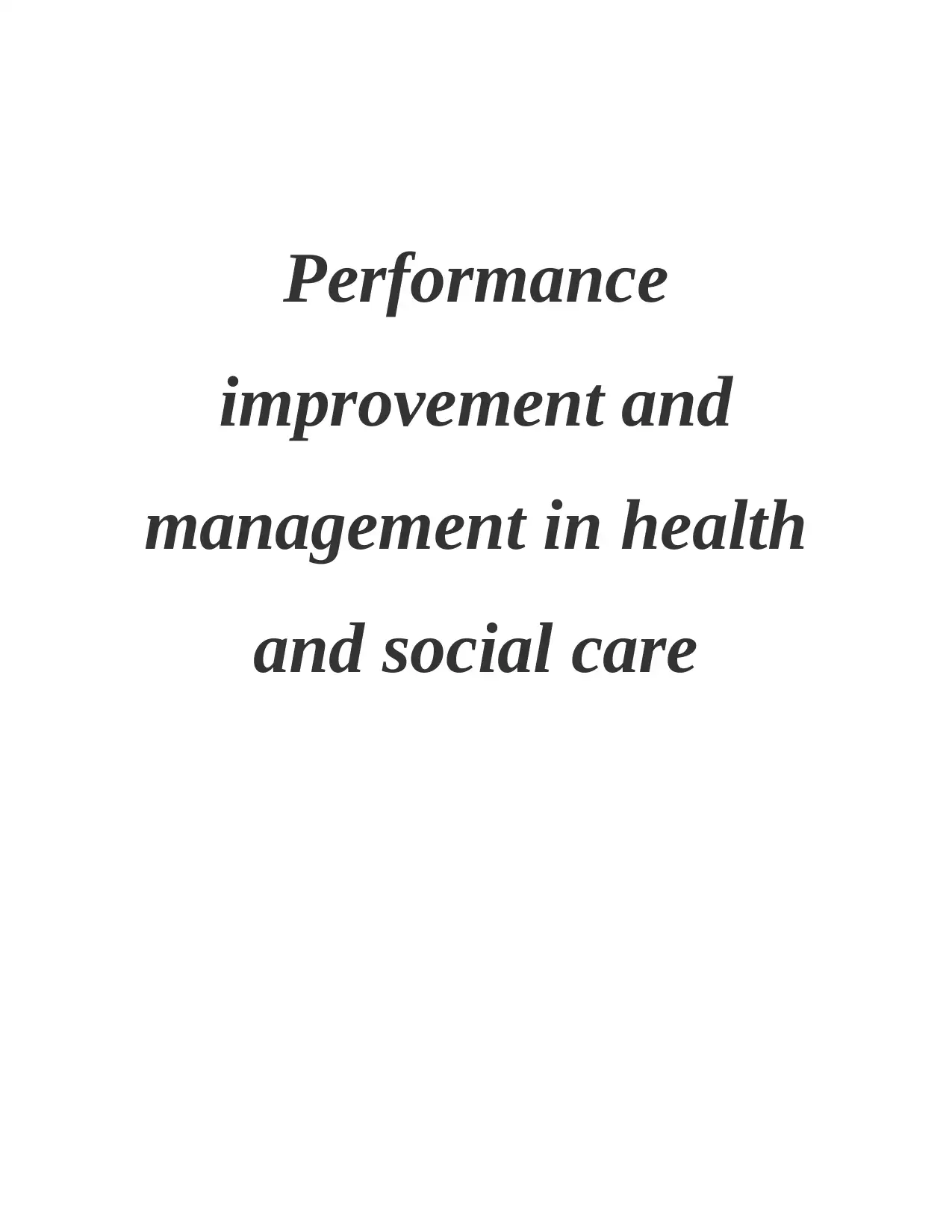
Performance
improvement and
management in health
and social care
improvement and
management in health
and social care
Paraphrase This Document
Need a fresh take? Get an instant paraphrase of this document with our AI Paraphraser
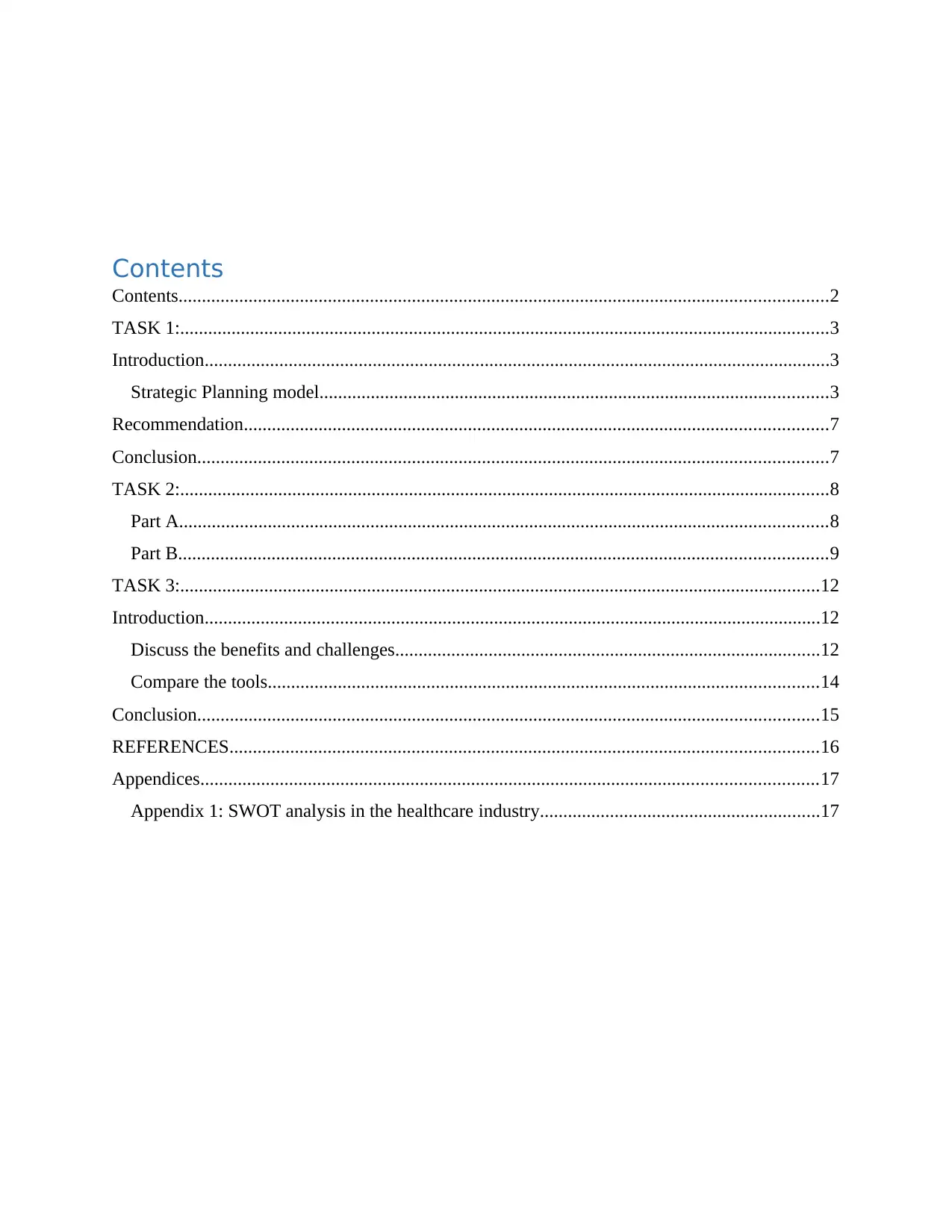
Contents
Contents...........................................................................................................................................2
TASK 1:...........................................................................................................................................3
Introduction......................................................................................................................................3
Strategic Planning model.............................................................................................................3
Recommendation.............................................................................................................................7
Conclusion.......................................................................................................................................7
TASK 2:...........................................................................................................................................8
Part A...........................................................................................................................................8
Part B...........................................................................................................................................9
TASK 3:.........................................................................................................................................12
Introduction....................................................................................................................................12
Discuss the benefits and challenges...........................................................................................12
Compare the tools......................................................................................................................14
Conclusion.....................................................................................................................................15
REFERENCES..............................................................................................................................16
Appendices....................................................................................................................................17
Appendix 1: SWOT analysis in the healthcare industry............................................................17
Contents...........................................................................................................................................2
TASK 1:...........................................................................................................................................3
Introduction......................................................................................................................................3
Strategic Planning model.............................................................................................................3
Recommendation.............................................................................................................................7
Conclusion.......................................................................................................................................7
TASK 2:...........................................................................................................................................8
Part A...........................................................................................................................................8
Part B...........................................................................................................................................9
TASK 3:.........................................................................................................................................12
Introduction....................................................................................................................................12
Discuss the benefits and challenges...........................................................................................12
Compare the tools......................................................................................................................14
Conclusion.....................................................................................................................................15
REFERENCES..............................................................................................................................16
Appendices....................................................................................................................................17
Appendix 1: SWOT analysis in the healthcare industry............................................................17
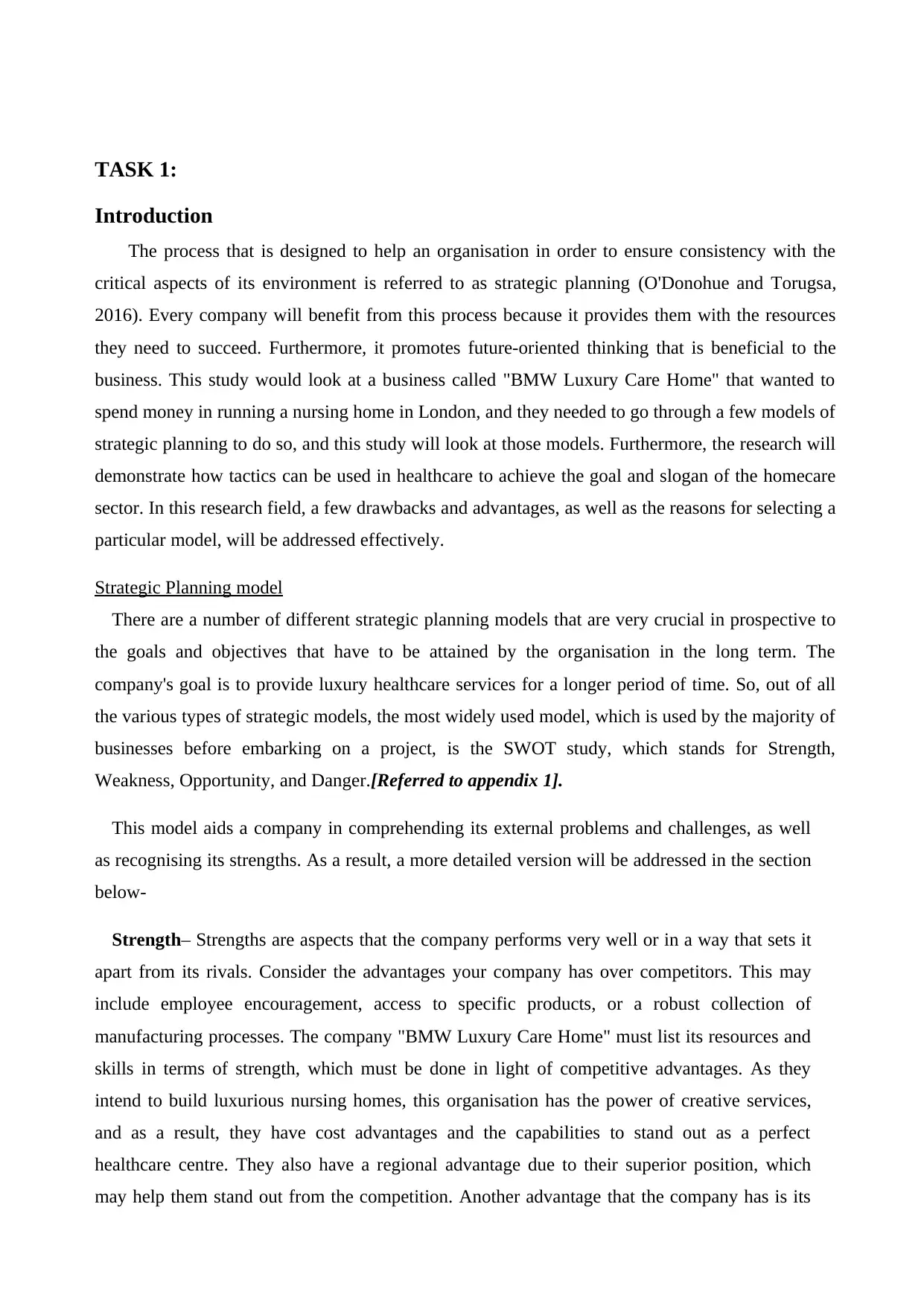
TASK 1:
Introduction
The process that is designed to help an organisation in order to ensure consistency with the
critical aspects of its environment is referred to as strategic planning (O'Donohue and Torugsa,
2016). Every company will benefit from this process because it provides them with the resources
they need to succeed. Furthermore, it promotes future-oriented thinking that is beneficial to the
business. This study would look at a business called "BMW Luxury Care Home" that wanted to
spend money in running a nursing home in London, and they needed to go through a few models of
strategic planning to do so, and this study will look at those models. Furthermore, the research will
demonstrate how tactics can be used in healthcare to achieve the goal and slogan of the homecare
sector. In this research field, a few drawbacks and advantages, as well as the reasons for selecting a
particular model, will be addressed effectively.
Strategic Planning model
There are a number of different strategic planning models that are very crucial in prospective to
the goals and objectives that have to be attained by the organisation in the long term. The
company's goal is to provide luxury healthcare services for a longer period of time. So, out of all
the various types of strategic models, the most widely used model, which is used by the majority of
businesses before embarking on a project, is the SWOT study, which stands for Strength,
Weakness, Opportunity, and Danger.[Referred to appendix 1].
This model aids a company in comprehending its external problems and challenges, as well
as recognising its strengths. As a result, a more detailed version will be addressed in the section
below-
Strength– Strengths are aspects that the company performs very well or in a way that sets it
apart from its rivals. Consider the advantages your company has over competitors. This may
include employee encouragement, access to specific products, or a robust collection of
manufacturing processes. The company "BMW Luxury Care Home" must list its resources and
skills in terms of strength, which must be done in light of competitive advantages. As they
intend to build luxurious nursing homes, this organisation has the power of creative services,
and as a result, they have cost advantages and the capabilities to stand out as a perfect
healthcare centre. They also have a regional advantage due to their superior position, which
may help them stand out from the competition. Another advantage that the company has is its
Introduction
The process that is designed to help an organisation in order to ensure consistency with the
critical aspects of its environment is referred to as strategic planning (O'Donohue and Torugsa,
2016). Every company will benefit from this process because it provides them with the resources
they need to succeed. Furthermore, it promotes future-oriented thinking that is beneficial to the
business. This study would look at a business called "BMW Luxury Care Home" that wanted to
spend money in running a nursing home in London, and they needed to go through a few models of
strategic planning to do so, and this study will look at those models. Furthermore, the research will
demonstrate how tactics can be used in healthcare to achieve the goal and slogan of the homecare
sector. In this research field, a few drawbacks and advantages, as well as the reasons for selecting a
particular model, will be addressed effectively.
Strategic Planning model
There are a number of different strategic planning models that are very crucial in prospective to
the goals and objectives that have to be attained by the organisation in the long term. The
company's goal is to provide luxury healthcare services for a longer period of time. So, out of all
the various types of strategic models, the most widely used model, which is used by the majority of
businesses before embarking on a project, is the SWOT study, which stands for Strength,
Weakness, Opportunity, and Danger.[Referred to appendix 1].
This model aids a company in comprehending its external problems and challenges, as well
as recognising its strengths. As a result, a more detailed version will be addressed in the section
below-
Strength– Strengths are aspects that the company performs very well or in a way that sets it
apart from its rivals. Consider the advantages your company has over competitors. This may
include employee encouragement, access to specific products, or a robust collection of
manufacturing processes. The company "BMW Luxury Care Home" must list its resources and
skills in terms of strength, which must be done in light of competitive advantages. As they
intend to build luxurious nursing homes, this organisation has the power of creative services,
and as a result, they have cost advantages and the capabilities to stand out as a perfect
healthcare centre. They also have a regional advantage due to their superior position, which
may help them stand out from the competition. Another advantage that the company has is its
⊘ This is a preview!⊘
Do you want full access?
Subscribe today to unlock all pages.

Trusted by 1+ million students worldwide
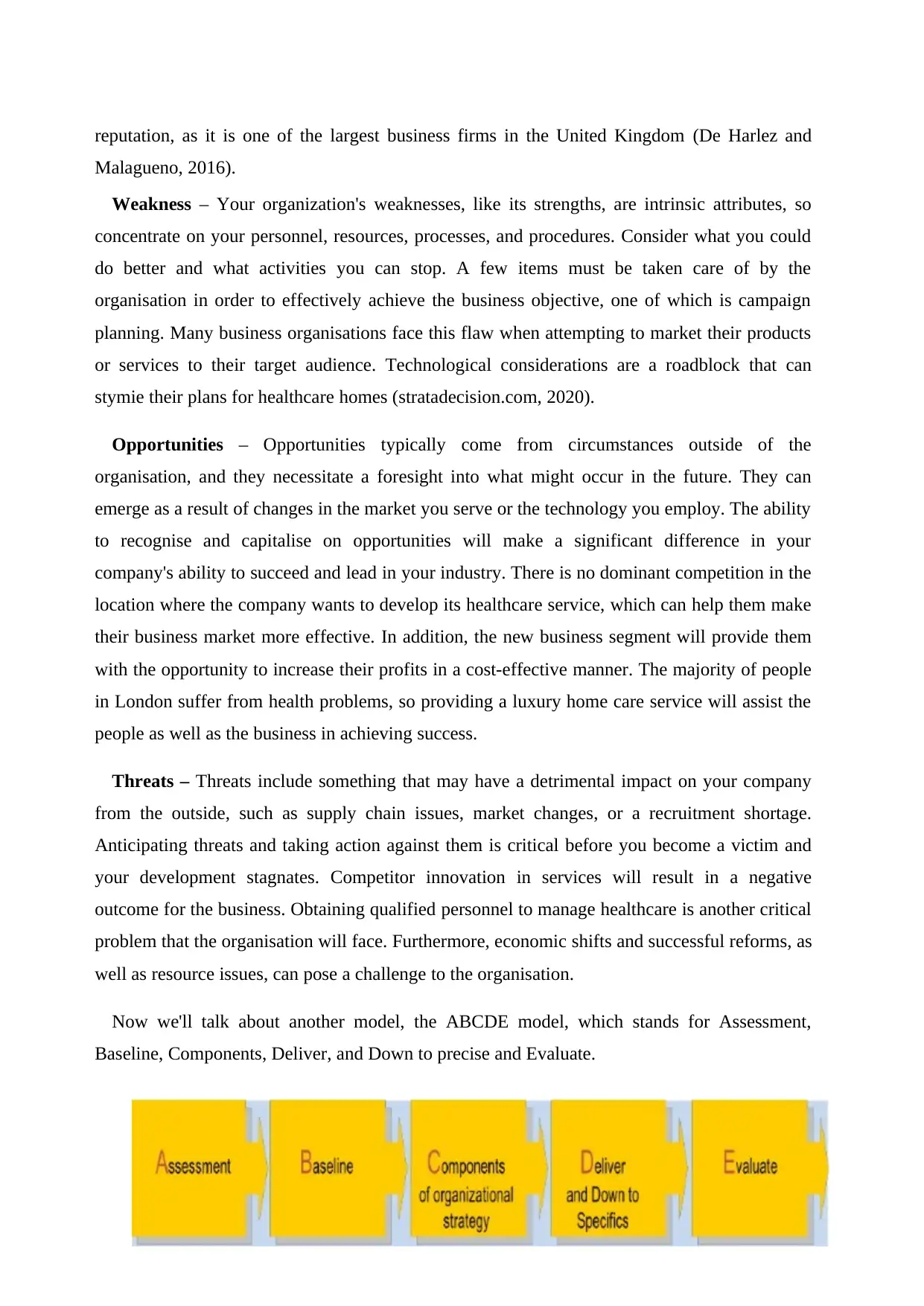
reputation, as it is one of the largest business firms in the United Kingdom (De Harlez and
Malagueno, 2016).
Weakness – Your organization's weaknesses, like its strengths, are intrinsic attributes, so
concentrate on your personnel, resources, processes, and procedures. Consider what you could
do better and what activities you can stop. A few items must be taken care of by the
organisation in order to effectively achieve the business objective, one of which is campaign
planning. Many business organisations face this flaw when attempting to market their products
or services to their target audience. Technological considerations are a roadblock that can
stymie their plans for healthcare homes (stratadecision.com, 2020).
Opportunities – Opportunities typically come from circumstances outside of the
organisation, and they necessitate a foresight into what might occur in the future. They can
emerge as a result of changes in the market you serve or the technology you employ. The ability
to recognise and capitalise on opportunities will make a significant difference in your
company's ability to succeed and lead in your industry. There is no dominant competition in the
location where the company wants to develop its healthcare service, which can help them make
their business market more effective. In addition, the new business segment will provide them
with the opportunity to increase their profits in a cost-effective manner. The majority of people
in London suffer from health problems, so providing a luxury home care service will assist the
people as well as the business in achieving success.
Threats – Threats include something that may have a detrimental impact on your company
from the outside, such as supply chain issues, market changes, or a recruitment shortage.
Anticipating threats and taking action against them is critical before you become a victim and
your development stagnates. Competitor innovation in services will result in a negative
outcome for the business. Obtaining qualified personnel to manage healthcare is another critical
problem that the organisation will face. Furthermore, economic shifts and successful reforms, as
well as resource issues, can pose a challenge to the organisation.
Now we'll talk about another model, the ABCDE model, which stands for Assessment,
Baseline, Components, Deliver, and Down to precise and Evaluate.
Malagueno, 2016).
Weakness – Your organization's weaknesses, like its strengths, are intrinsic attributes, so
concentrate on your personnel, resources, processes, and procedures. Consider what you could
do better and what activities you can stop. A few items must be taken care of by the
organisation in order to effectively achieve the business objective, one of which is campaign
planning. Many business organisations face this flaw when attempting to market their products
or services to their target audience. Technological considerations are a roadblock that can
stymie their plans for healthcare homes (stratadecision.com, 2020).
Opportunities – Opportunities typically come from circumstances outside of the
organisation, and they necessitate a foresight into what might occur in the future. They can
emerge as a result of changes in the market you serve or the technology you employ. The ability
to recognise and capitalise on opportunities will make a significant difference in your
company's ability to succeed and lead in your industry. There is no dominant competition in the
location where the company wants to develop its healthcare service, which can help them make
their business market more effective. In addition, the new business segment will provide them
with the opportunity to increase their profits in a cost-effective manner. The majority of people
in London suffer from health problems, so providing a luxury home care service will assist the
people as well as the business in achieving success.
Threats – Threats include something that may have a detrimental impact on your company
from the outside, such as supply chain issues, market changes, or a recruitment shortage.
Anticipating threats and taking action against them is critical before you become a victim and
your development stagnates. Competitor innovation in services will result in a negative
outcome for the business. Obtaining qualified personnel to manage healthcare is another critical
problem that the organisation will face. Furthermore, economic shifts and successful reforms, as
well as resource issues, can pose a challenge to the organisation.
Now we'll talk about another model, the ABCDE model, which stands for Assessment,
Baseline, Components, Deliver, and Down to precise and Evaluate.
Paraphrase This Document
Need a fresh take? Get an instant paraphrase of this document with our AI Paraphraser
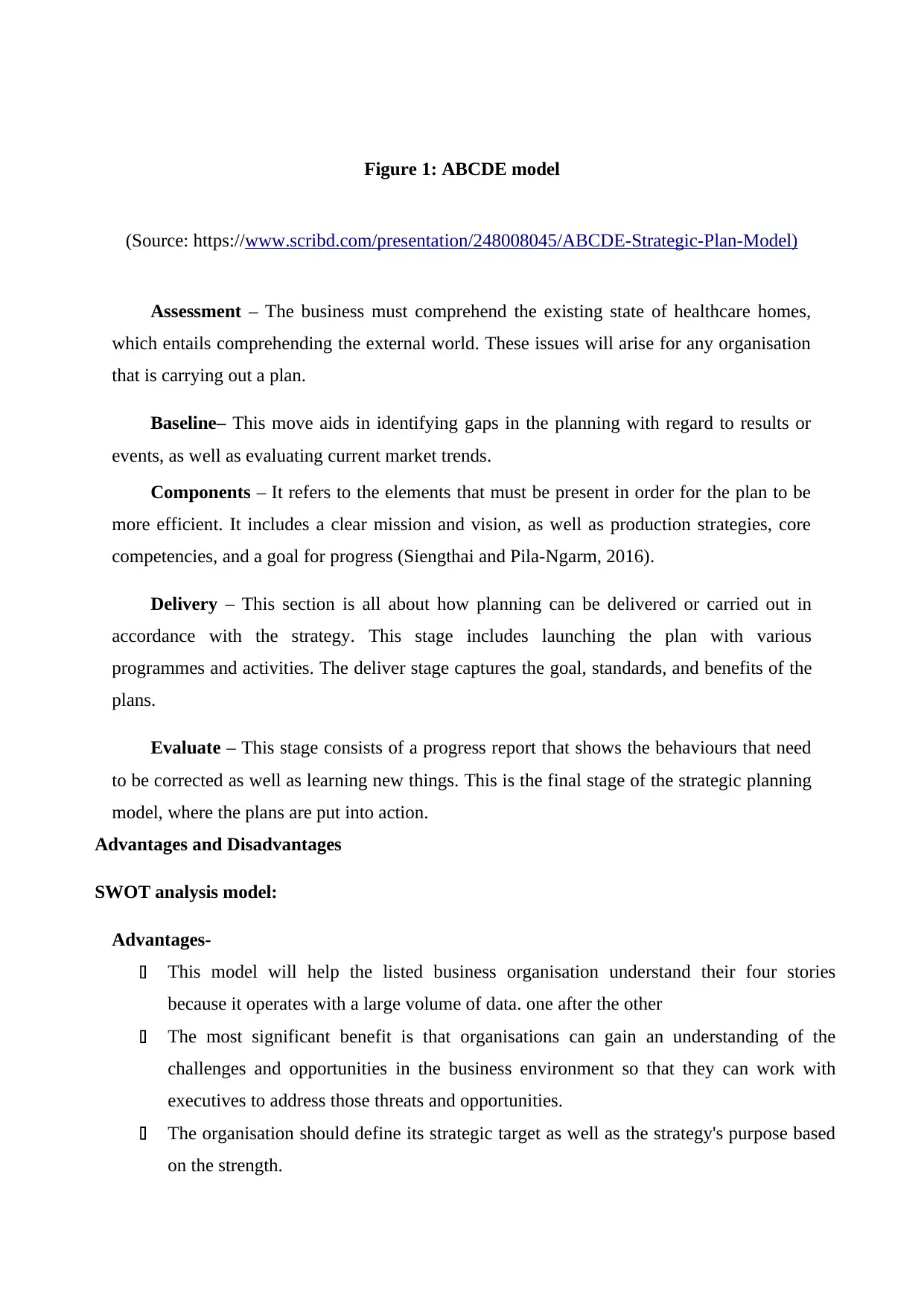
Figure 1: ABCDE model
(Source: https://www.scribd.com/presentation/248008045/ABCDE-Strategic-Plan-Model)
Assessment – The business must comprehend the existing state of healthcare homes,
which entails comprehending the external world. These issues will arise for any organisation
that is carrying out a plan.
Baseline– This move aids in identifying gaps in the planning with regard to results or
events, as well as evaluating current market trends.
Components – It refers to the elements that must be present in order for the plan to be
more efficient. It includes a clear mission and vision, as well as production strategies, core
competencies, and a goal for progress (Siengthai and Pila-Ngarm, 2016).
Delivery – This section is all about how planning can be delivered or carried out in
accordance with the strategy. This stage includes launching the plan with various
programmes and activities. The deliver stage captures the goal, standards, and benefits of the
plans.
Evaluate – This stage consists of a progress report that shows the behaviours that need
to be corrected as well as learning new things. This is the final stage of the strategic planning
model, where the plans are put into action.
Advantages and Disadvantages
SWOT analysis model:
Advantages-
This model will help the listed business organisation understand their four stories
because it operates with a large volume of data. one after the other
The most significant benefit is that organisations can gain an understanding of the
challenges and opportunities in the business environment so that they can work with
executives to address those threats and opportunities.
The organisation should define its strategic target as well as the strategy's purpose based
on the strength.
(Source: https://www.scribd.com/presentation/248008045/ABCDE-Strategic-Plan-Model)
Assessment – The business must comprehend the existing state of healthcare homes,
which entails comprehending the external world. These issues will arise for any organisation
that is carrying out a plan.
Baseline– This move aids in identifying gaps in the planning with regard to results or
events, as well as evaluating current market trends.
Components – It refers to the elements that must be present in order for the plan to be
more efficient. It includes a clear mission and vision, as well as production strategies, core
competencies, and a goal for progress (Siengthai and Pila-Ngarm, 2016).
Delivery – This section is all about how planning can be delivered or carried out in
accordance with the strategy. This stage includes launching the plan with various
programmes and activities. The deliver stage captures the goal, standards, and benefits of the
plans.
Evaluate – This stage consists of a progress report that shows the behaviours that need
to be corrected as well as learning new things. This is the final stage of the strategic planning
model, where the plans are put into action.
Advantages and Disadvantages
SWOT analysis model:
Advantages-
This model will help the listed business organisation understand their four stories
because it operates with a large volume of data. one after the other
The most significant benefit is that organisations can gain an understanding of the
challenges and opportunities in the business environment so that they can work with
executives to address those threats and opportunities.
The organisation should define its strategic target as well as the strategy's purpose based
on the strength.
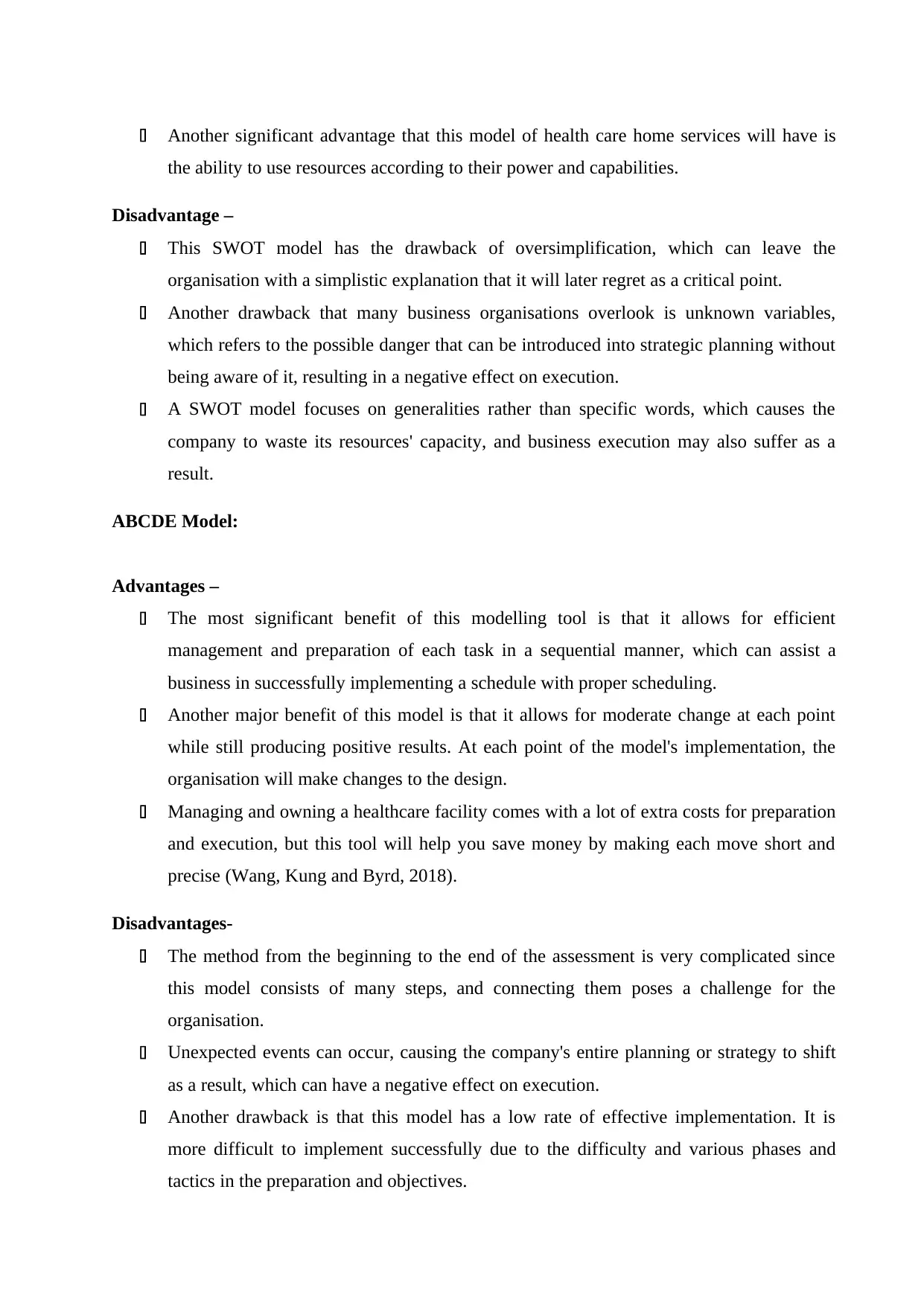
Another significant advantage that this model of health care home services will have is
the ability to use resources according to their power and capabilities.
Disadvantage –
This SWOT model has the drawback of oversimplification, which can leave the
organisation with a simplistic explanation that it will later regret as a critical point.
Another drawback that many business organisations overlook is unknown variables,
which refers to the possible danger that can be introduced into strategic planning without
being aware of it, resulting in a negative effect on execution.
A SWOT model focuses on generalities rather than specific words, which causes the
company to waste its resources' capacity, and business execution may also suffer as a
result.
ABCDE Model:
Advantages –
The most significant benefit of this modelling tool is that it allows for efficient
management and preparation of each task in a sequential manner, which can assist a
business in successfully implementing a schedule with proper scheduling.
Another major benefit of this model is that it allows for moderate change at each point
while still producing positive results. At each point of the model's implementation, the
organisation will make changes to the design.
Managing and owning a healthcare facility comes with a lot of extra costs for preparation
and execution, but this tool will help you save money by making each move short and
precise (Wang, Kung and Byrd, 2018).
Disadvantages-
The method from the beginning to the end of the assessment is very complicated since
this model consists of many steps, and connecting them poses a challenge for the
organisation.
Unexpected events can occur, causing the company's entire planning or strategy to shift
as a result, which can have a negative effect on execution.
Another drawback is that this model has a low rate of effective implementation. It is
more difficult to implement successfully due to the difficulty and various phases and
tactics in the preparation and objectives.
the ability to use resources according to their power and capabilities.
Disadvantage –
This SWOT model has the drawback of oversimplification, which can leave the
organisation with a simplistic explanation that it will later regret as a critical point.
Another drawback that many business organisations overlook is unknown variables,
which refers to the possible danger that can be introduced into strategic planning without
being aware of it, resulting in a negative effect on execution.
A SWOT model focuses on generalities rather than specific words, which causes the
company to waste its resources' capacity, and business execution may also suffer as a
result.
ABCDE Model:
Advantages –
The most significant benefit of this modelling tool is that it allows for efficient
management and preparation of each task in a sequential manner, which can assist a
business in successfully implementing a schedule with proper scheduling.
Another major benefit of this model is that it allows for moderate change at each point
while still producing positive results. At each point of the model's implementation, the
organisation will make changes to the design.
Managing and owning a healthcare facility comes with a lot of extra costs for preparation
and execution, but this tool will help you save money by making each move short and
precise (Wang, Kung and Byrd, 2018).
Disadvantages-
The method from the beginning to the end of the assessment is very complicated since
this model consists of many steps, and connecting them poses a challenge for the
organisation.
Unexpected events can occur, causing the company's entire planning or strategy to shift
as a result, which can have a negative effect on execution.
Another drawback is that this model has a low rate of effective implementation. It is
more difficult to implement successfully due to the difficulty and various phases and
tactics in the preparation and objectives.
⊘ This is a preview!⊘
Do you want full access?
Subscribe today to unlock all pages.

Trusted by 1+ million students worldwide
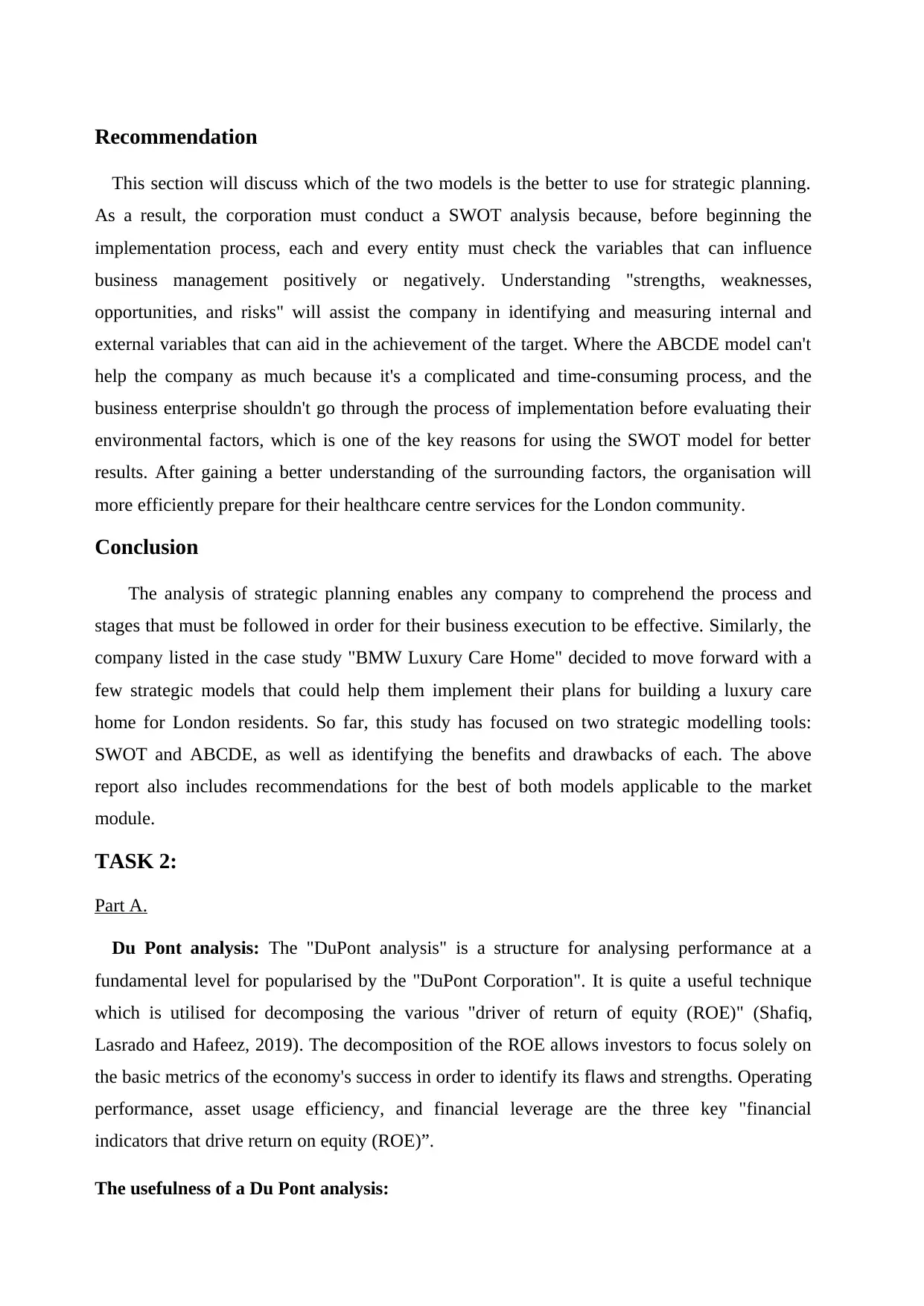
Recommendation
This section will discuss which of the two models is the better to use for strategic planning.
As a result, the corporation must conduct a SWOT analysis because, before beginning the
implementation process, each and every entity must check the variables that can influence
business management positively or negatively. Understanding "strengths, weaknesses,
opportunities, and risks" will assist the company in identifying and measuring internal and
external variables that can aid in the achievement of the target. Where the ABCDE model can't
help the company as much because it's a complicated and time-consuming process, and the
business enterprise shouldn't go through the process of implementation before evaluating their
environmental factors, which is one of the key reasons for using the SWOT model for better
results. After gaining a better understanding of the surrounding factors, the organisation will
more efficiently prepare for their healthcare centre services for the London community.
Conclusion
The analysis of strategic planning enables any company to comprehend the process and
stages that must be followed in order for their business execution to be effective. Similarly, the
company listed in the case study "BMW Luxury Care Home" decided to move forward with a
few strategic models that could help them implement their plans for building a luxury care
home for London residents. So far, this study has focused on two strategic modelling tools:
SWOT and ABCDE, as well as identifying the benefits and drawbacks of each. The above
report also includes recommendations for the best of both models applicable to the market
module.
TASK 2:
Part A.
Du Pont analysis: The "DuPont analysis" is a structure for analysing performance at a
fundamental level for popularised by the "DuPont Corporation". It is quite a useful technique
which is utilised for decomposing the various "driver of return of equity (ROE)" (Shafiq,
Lasrado and Hafeez, 2019). The decomposition of the ROE allows investors to focus solely on
the basic metrics of the economy's success in order to identify its flaws and strengths. Operating
performance, asset usage efficiency, and financial leverage are the three key "financial
indicators that drive return on equity (ROE)”.
The usefulness of a Du Pont analysis:
This section will discuss which of the two models is the better to use for strategic planning.
As a result, the corporation must conduct a SWOT analysis because, before beginning the
implementation process, each and every entity must check the variables that can influence
business management positively or negatively. Understanding "strengths, weaknesses,
opportunities, and risks" will assist the company in identifying and measuring internal and
external variables that can aid in the achievement of the target. Where the ABCDE model can't
help the company as much because it's a complicated and time-consuming process, and the
business enterprise shouldn't go through the process of implementation before evaluating their
environmental factors, which is one of the key reasons for using the SWOT model for better
results. After gaining a better understanding of the surrounding factors, the organisation will
more efficiently prepare for their healthcare centre services for the London community.
Conclusion
The analysis of strategic planning enables any company to comprehend the process and
stages that must be followed in order for their business execution to be effective. Similarly, the
company listed in the case study "BMW Luxury Care Home" decided to move forward with a
few strategic models that could help them implement their plans for building a luxury care
home for London residents. So far, this study has focused on two strategic modelling tools:
SWOT and ABCDE, as well as identifying the benefits and drawbacks of each. The above
report also includes recommendations for the best of both models applicable to the market
module.
TASK 2:
Part A.
Du Pont analysis: The "DuPont analysis" is a structure for analysing performance at a
fundamental level for popularised by the "DuPont Corporation". It is quite a useful technique
which is utilised for decomposing the various "driver of return of equity (ROE)" (Shafiq,
Lasrado and Hafeez, 2019). The decomposition of the ROE allows investors to focus solely on
the basic metrics of the economy's success in order to identify its flaws and strengths. Operating
performance, asset usage efficiency, and financial leverage are the three key "financial
indicators that drive return on equity (ROE)”.
The usefulness of a Du Pont analysis:
Paraphrase This Document
Need a fresh take? Get an instant paraphrase of this document with our AI Paraphraser
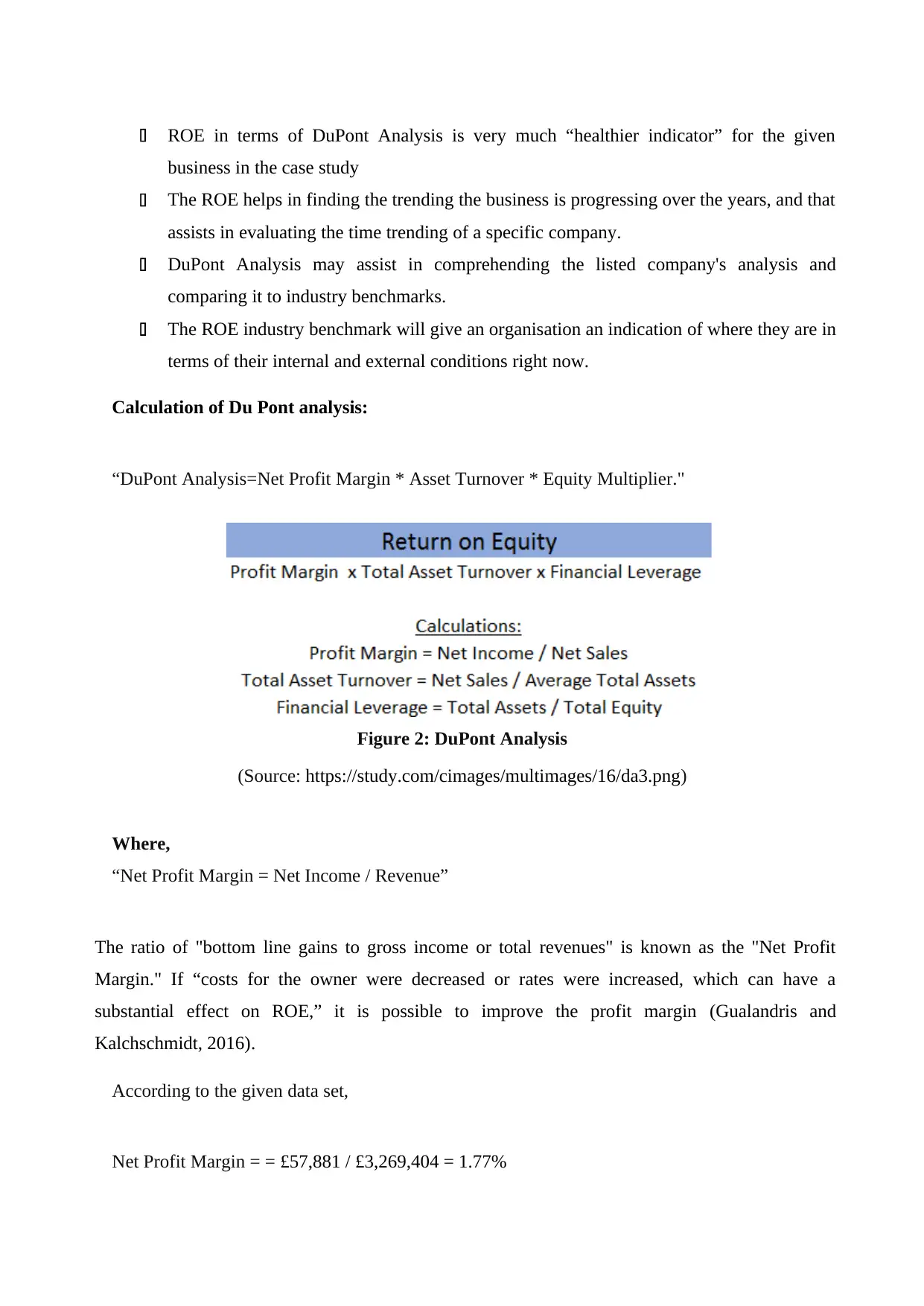
ROE in terms of DuPont Analysis is very much “healthier indicator” for the given
business in the case study
The ROE helps in finding the trending the business is progressing over the years, and that
assists in evaluating the time trending of a specific company.
DuPont Analysis may assist in comprehending the listed company's analysis and
comparing it to industry benchmarks.
The ROE industry benchmark will give an organisation an indication of where they are in
terms of their internal and external conditions right now.
Calculation of Du Pont analysis:
“DuPont Analysis=Net Profit Margin * Asset Turnover * Equity Multiplier."
Figure 2: DuPont Analysis
(Source: https://study.com/cimages/multimages/16/da3.png)
Where,
“Net Profit Margin = Net Income / Revenue”
The ratio of "bottom line gains to gross income or total revenues" is known as the "Net Profit
Margin." If “costs for the owner were decreased or rates were increased, which can have a
substantial effect on ROE,” it is possible to improve the profit margin (Gualandris and
Kalchschmidt, 2016).
According to the given data set,
Net Profit Margin = = £57,881 / £3,269,404 = 1.77%
business in the case study
The ROE helps in finding the trending the business is progressing over the years, and that
assists in evaluating the time trending of a specific company.
DuPont Analysis may assist in comprehending the listed company's analysis and
comparing it to industry benchmarks.
The ROE industry benchmark will give an organisation an indication of where they are in
terms of their internal and external conditions right now.
Calculation of Du Pont analysis:
“DuPont Analysis=Net Profit Margin * Asset Turnover * Equity Multiplier."
Figure 2: DuPont Analysis
(Source: https://study.com/cimages/multimages/16/da3.png)
Where,
“Net Profit Margin = Net Income / Revenue”
The ratio of "bottom line gains to gross income or total revenues" is known as the "Net Profit
Margin." If “costs for the owner were decreased or rates were increased, which can have a
substantial effect on ROE,” it is possible to improve the profit margin (Gualandris and
Kalchschmidt, 2016).
According to the given data set,
Net Profit Margin = = £57,881 / £3,269,404 = 1.77%
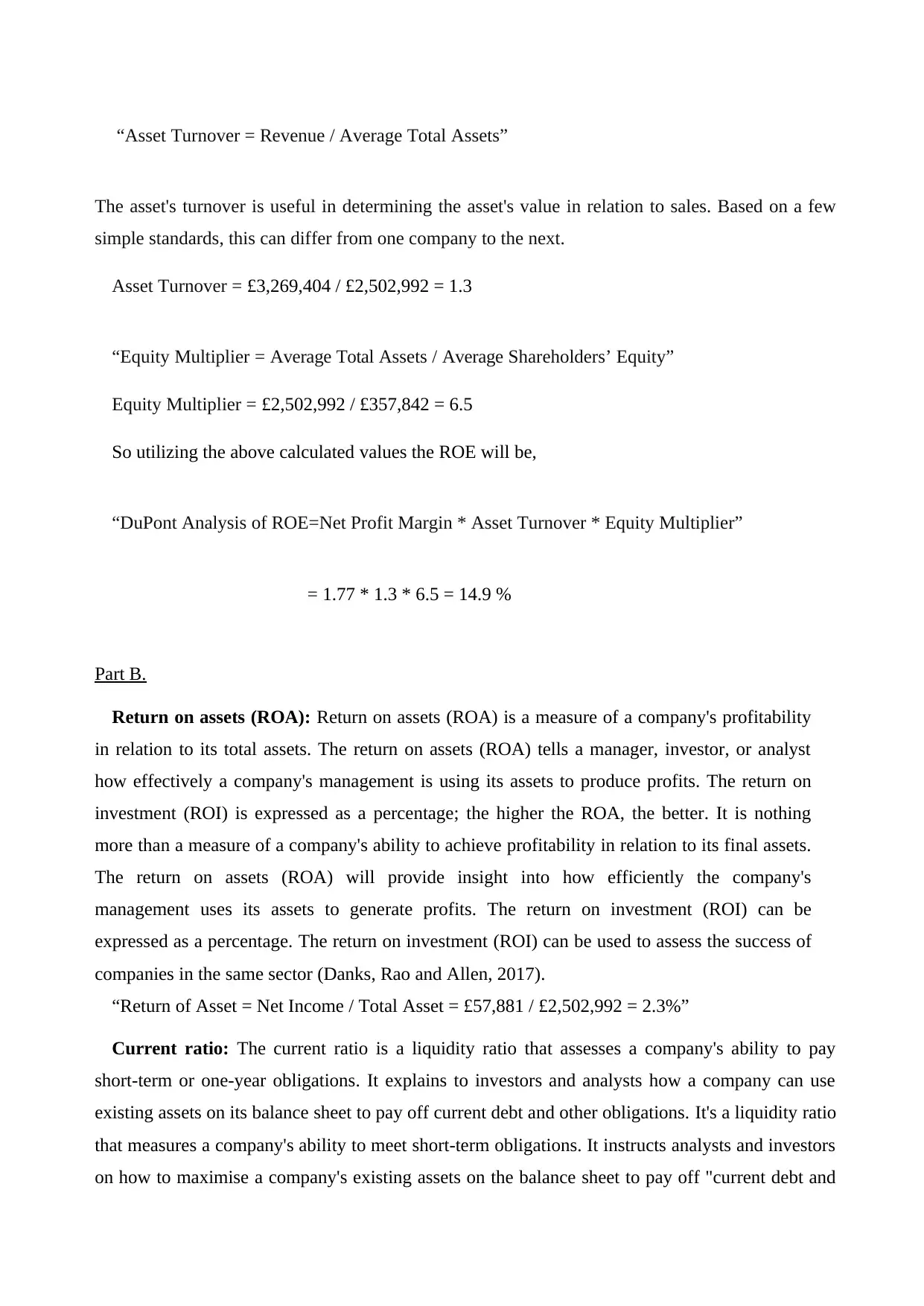
“Asset Turnover = Revenue / Average Total Assets”
The asset's turnover is useful in determining the asset's value in relation to sales. Based on a few
simple standards, this can differ from one company to the next.
Asset Turnover = £3,269,404 / £2,502,992 = 1.3
“Equity Multiplier = Average Total Assets / Average Shareholders’ Equity”
Equity Multiplier = £2,502,992 / £357,842 = 6.5
So utilizing the above calculated values the ROE will be,
“DuPont Analysis of ROE=Net Profit Margin * Asset Turnover * Equity Multiplier”
= 1.77 * 1.3 * 6.5 = 14.9 %
Part B.
Return on assets (ROA): Return on assets (ROA) is a measure of a company's profitability
in relation to its total assets. The return on assets (ROA) tells a manager, investor, or analyst
how effectively a company's management is using its assets to produce profits. The return on
investment (ROI) is expressed as a percentage; the higher the ROA, the better. It is nothing
more than a measure of a company's ability to achieve profitability in relation to its final assets.
The return on assets (ROA) will provide insight into how efficiently the company's
management uses its assets to generate profits. The return on investment (ROI) can be
expressed as a percentage. The return on investment (ROI) can be used to assess the success of
companies in the same sector (Danks, Rao and Allen, 2017).
“Return of Asset = Net Income / Total Asset = £57,881 / £2,502,992 = 2.3%”
Current ratio: The current ratio is a liquidity ratio that assesses a company's ability to pay
short-term or one-year obligations. It explains to investors and analysts how a company can use
existing assets on its balance sheet to pay off current debt and other obligations. It's a liquidity ratio
that measures a company's ability to meet short-term obligations. It instructs analysts and investors
on how to maximise a company's existing assets on the balance sheet to pay off "current debt and
The asset's turnover is useful in determining the asset's value in relation to sales. Based on a few
simple standards, this can differ from one company to the next.
Asset Turnover = £3,269,404 / £2,502,992 = 1.3
“Equity Multiplier = Average Total Assets / Average Shareholders’ Equity”
Equity Multiplier = £2,502,992 / £357,842 = 6.5
So utilizing the above calculated values the ROE will be,
“DuPont Analysis of ROE=Net Profit Margin * Asset Turnover * Equity Multiplier”
= 1.77 * 1.3 * 6.5 = 14.9 %
Part B.
Return on assets (ROA): Return on assets (ROA) is a measure of a company's profitability
in relation to its total assets. The return on assets (ROA) tells a manager, investor, or analyst
how effectively a company's management is using its assets to produce profits. The return on
investment (ROI) is expressed as a percentage; the higher the ROA, the better. It is nothing
more than a measure of a company's ability to achieve profitability in relation to its final assets.
The return on assets (ROA) will provide insight into how efficiently the company's
management uses its assets to generate profits. The return on investment (ROI) can be
expressed as a percentage. The return on investment (ROI) can be used to assess the success of
companies in the same sector (Danks, Rao and Allen, 2017).
“Return of Asset = Net Income / Total Asset = £57,881 / £2,502,992 = 2.3%”
Current ratio: The current ratio is a liquidity ratio that assesses a company's ability to pay
short-term or one-year obligations. It explains to investors and analysts how a company can use
existing assets on its balance sheet to pay off current debt and other obligations. It's a liquidity ratio
that measures a company's ability to meet short-term obligations. It instructs analysts and investors
on how to maximise a company's existing assets on the balance sheet to pay off "current debt and
⊘ This is a preview!⊘
Do you want full access?
Subscribe today to unlock all pages.

Trusted by 1+ million students worldwide
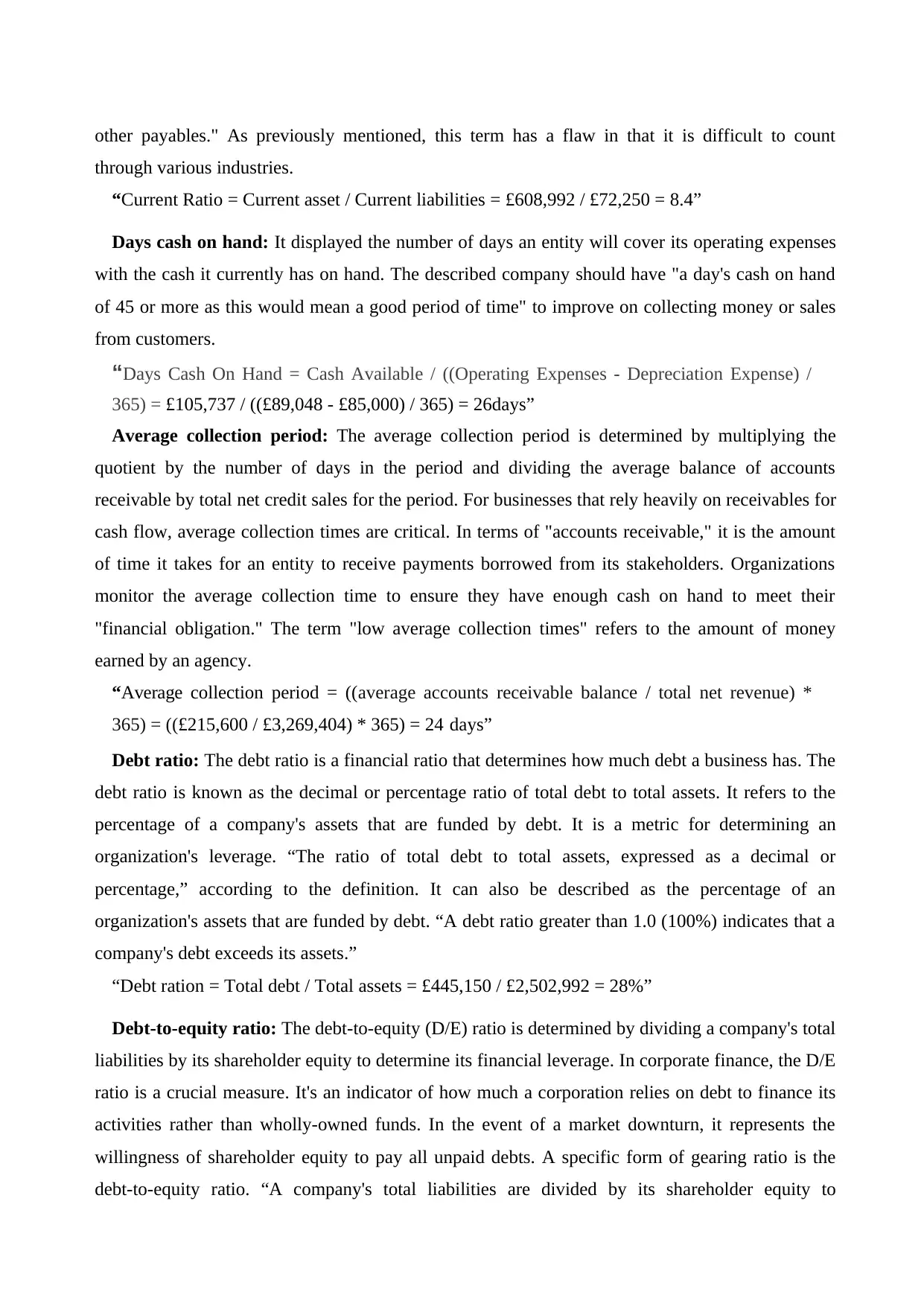
other payables." As previously mentioned, this term has a flaw in that it is difficult to count
through various industries.
“Current Ratio = Current asset / Current liabilities = £608,992 / £72,250 = 8.4”
Days cash on hand: It displayed the number of days an entity will cover its operating expenses
with the cash it currently has on hand. The described company should have "a day's cash on hand
of 45 or more as this would mean a good period of time" to improve on collecting money or sales
from customers.
“Days Cash On Hand = Cash Available / ((Operating Expenses - Depreciation Expense) /
365) = £105,737 / ((£89,048 - £85,000) / 365) = 26days”
Average collection period: The average collection period is determined by multiplying the
quotient by the number of days in the period and dividing the average balance of accounts
receivable by total net credit sales for the period. For businesses that rely heavily on receivables for
cash flow, average collection times are critical. In terms of "accounts receivable," it is the amount
of time it takes for an entity to receive payments borrowed from its stakeholders. Organizations
monitor the average collection time to ensure they have enough cash on hand to meet their
"financial obligation." The term "low average collection times" refers to the amount of money
earned by an agency.
“Average collection period = ((average accounts receivable balance / total net revenue) *
365) = ((£215,600 / £3,269,404) * 365) = 24 days”
Debt ratio: The debt ratio is a financial ratio that determines how much debt a business has. The
debt ratio is known as the decimal or percentage ratio of total debt to total assets. It refers to the
percentage of a company's assets that are funded by debt. It is a metric for determining an
organization's leverage. “The ratio of total debt to total assets, expressed as a decimal or
percentage,” according to the definition. It can also be described as the percentage of an
organization's assets that are funded by debt. “A debt ratio greater than 1.0 (100%) indicates that a
company's debt exceeds its assets.”
“Debt ration = Total debt / Total assets = £445,150 / £2,502,992 = 28%”
Debt-to-equity ratio: The debt-to-equity (D/E) ratio is determined by dividing a company's total
liabilities by its shareholder equity to determine its financial leverage. In corporate finance, the D/E
ratio is a crucial measure. It's an indicator of how much a corporation relies on debt to finance its
activities rather than wholly-owned funds. In the event of a market downturn, it represents the
willingness of shareholder equity to pay all unpaid debts. A specific form of gearing ratio is the
debt-to-equity ratio. “A company's total liabilities are divided by its shareholder equity to
through various industries.
“Current Ratio = Current asset / Current liabilities = £608,992 / £72,250 = 8.4”
Days cash on hand: It displayed the number of days an entity will cover its operating expenses
with the cash it currently has on hand. The described company should have "a day's cash on hand
of 45 or more as this would mean a good period of time" to improve on collecting money or sales
from customers.
“Days Cash On Hand = Cash Available / ((Operating Expenses - Depreciation Expense) /
365) = £105,737 / ((£89,048 - £85,000) / 365) = 26days”
Average collection period: The average collection period is determined by multiplying the
quotient by the number of days in the period and dividing the average balance of accounts
receivable by total net credit sales for the period. For businesses that rely heavily on receivables for
cash flow, average collection times are critical. In terms of "accounts receivable," it is the amount
of time it takes for an entity to receive payments borrowed from its stakeholders. Organizations
monitor the average collection time to ensure they have enough cash on hand to meet their
"financial obligation." The term "low average collection times" refers to the amount of money
earned by an agency.
“Average collection period = ((average accounts receivable balance / total net revenue) *
365) = ((£215,600 / £3,269,404) * 365) = 24 days”
Debt ratio: The debt ratio is a financial ratio that determines how much debt a business has. The
debt ratio is known as the decimal or percentage ratio of total debt to total assets. It refers to the
percentage of a company's assets that are funded by debt. It is a metric for determining an
organization's leverage. “The ratio of total debt to total assets, expressed as a decimal or
percentage,” according to the definition. It can also be described as the percentage of an
organization's assets that are funded by debt. “A debt ratio greater than 1.0 (100%) indicates that a
company's debt exceeds its assets.”
“Debt ration = Total debt / Total assets = £445,150 / £2,502,992 = 28%”
Debt-to-equity ratio: The debt-to-equity (D/E) ratio is determined by dividing a company's total
liabilities by its shareholder equity to determine its financial leverage. In corporate finance, the D/E
ratio is a crucial measure. It's an indicator of how much a corporation relies on debt to finance its
activities rather than wholly-owned funds. In the event of a market downturn, it represents the
willingness of shareholder equity to pay all unpaid debts. A specific form of gearing ratio is the
debt-to-equity ratio. “A company's total liabilities are divided by its shareholder equity to
Paraphrase This Document
Need a fresh take? Get an instant paraphrase of this document with our AI Paraphraser
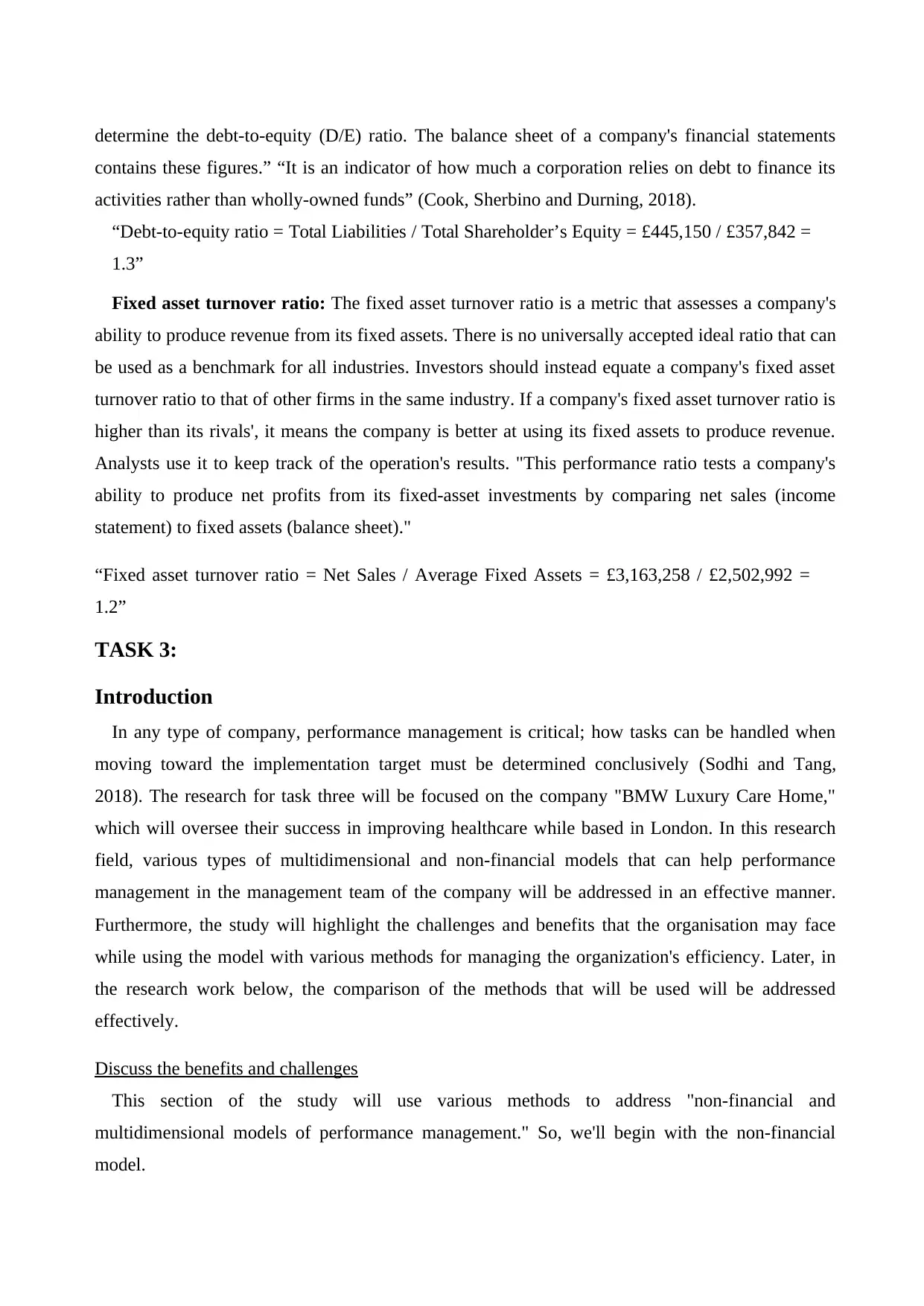
determine the debt-to-equity (D/E) ratio. The balance sheet of a company's financial statements
contains these figures.” “It is an indicator of how much a corporation relies on debt to finance its
activities rather than wholly-owned funds” (Cook, Sherbino and Durning, 2018).
“Debt-to-equity ratio = Total Liabilities / Total Shareholder’s Equity = £445,150 / £357,842 =
1.3”
Fixed asset turnover ratio: The fixed asset turnover ratio is a metric that assesses a company's
ability to produce revenue from its fixed assets. There is no universally accepted ideal ratio that can
be used as a benchmark for all industries. Investors should instead equate a company's fixed asset
turnover ratio to that of other firms in the same industry. If a company's fixed asset turnover ratio is
higher than its rivals', it means the company is better at using its fixed assets to produce revenue.
Analysts use it to keep track of the operation's results. "This performance ratio tests a company's
ability to produce net profits from its fixed-asset investments by comparing net sales (income
statement) to fixed assets (balance sheet)."
“Fixed asset turnover ratio = Net Sales / Average Fixed Assets = £3,163,258 / £2,502,992 =
1.2”
TASK 3:
Introduction
In any type of company, performance management is critical; how tasks can be handled when
moving toward the implementation target must be determined conclusively (Sodhi and Tang,
2018). The research for task three will be focused on the company "BMW Luxury Care Home,"
which will oversee their success in improving healthcare while based in London. In this research
field, various types of multidimensional and non-financial models that can help performance
management in the management team of the company will be addressed in an effective manner.
Furthermore, the study will highlight the challenges and benefits that the organisation may face
while using the model with various methods for managing the organization's efficiency. Later, in
the research work below, the comparison of the methods that will be used will be addressed
effectively.
Discuss the benefits and challenges
This section of the study will use various methods to address "non-financial and
multidimensional models of performance management." So, we'll begin with the non-financial
model.
contains these figures.” “It is an indicator of how much a corporation relies on debt to finance its
activities rather than wholly-owned funds” (Cook, Sherbino and Durning, 2018).
“Debt-to-equity ratio = Total Liabilities / Total Shareholder’s Equity = £445,150 / £357,842 =
1.3”
Fixed asset turnover ratio: The fixed asset turnover ratio is a metric that assesses a company's
ability to produce revenue from its fixed assets. There is no universally accepted ideal ratio that can
be used as a benchmark for all industries. Investors should instead equate a company's fixed asset
turnover ratio to that of other firms in the same industry. If a company's fixed asset turnover ratio is
higher than its rivals', it means the company is better at using its fixed assets to produce revenue.
Analysts use it to keep track of the operation's results. "This performance ratio tests a company's
ability to produce net profits from its fixed-asset investments by comparing net sales (income
statement) to fixed assets (balance sheet)."
“Fixed asset turnover ratio = Net Sales / Average Fixed Assets = £3,163,258 / £2,502,992 =
1.2”
TASK 3:
Introduction
In any type of company, performance management is critical; how tasks can be handled when
moving toward the implementation target must be determined conclusively (Sodhi and Tang,
2018). The research for task three will be focused on the company "BMW Luxury Care Home,"
which will oversee their success in improving healthcare while based in London. In this research
field, various types of multidimensional and non-financial models that can help performance
management in the management team of the company will be addressed in an effective manner.
Furthermore, the study will highlight the challenges and benefits that the organisation may face
while using the model with various methods for managing the organization's efficiency. Later, in
the research work below, the comparison of the methods that will be used will be addressed
effectively.
Discuss the benefits and challenges
This section of the study will use various methods to address "non-financial and
multidimensional models of performance management." So, we'll begin with the non-financial
model.
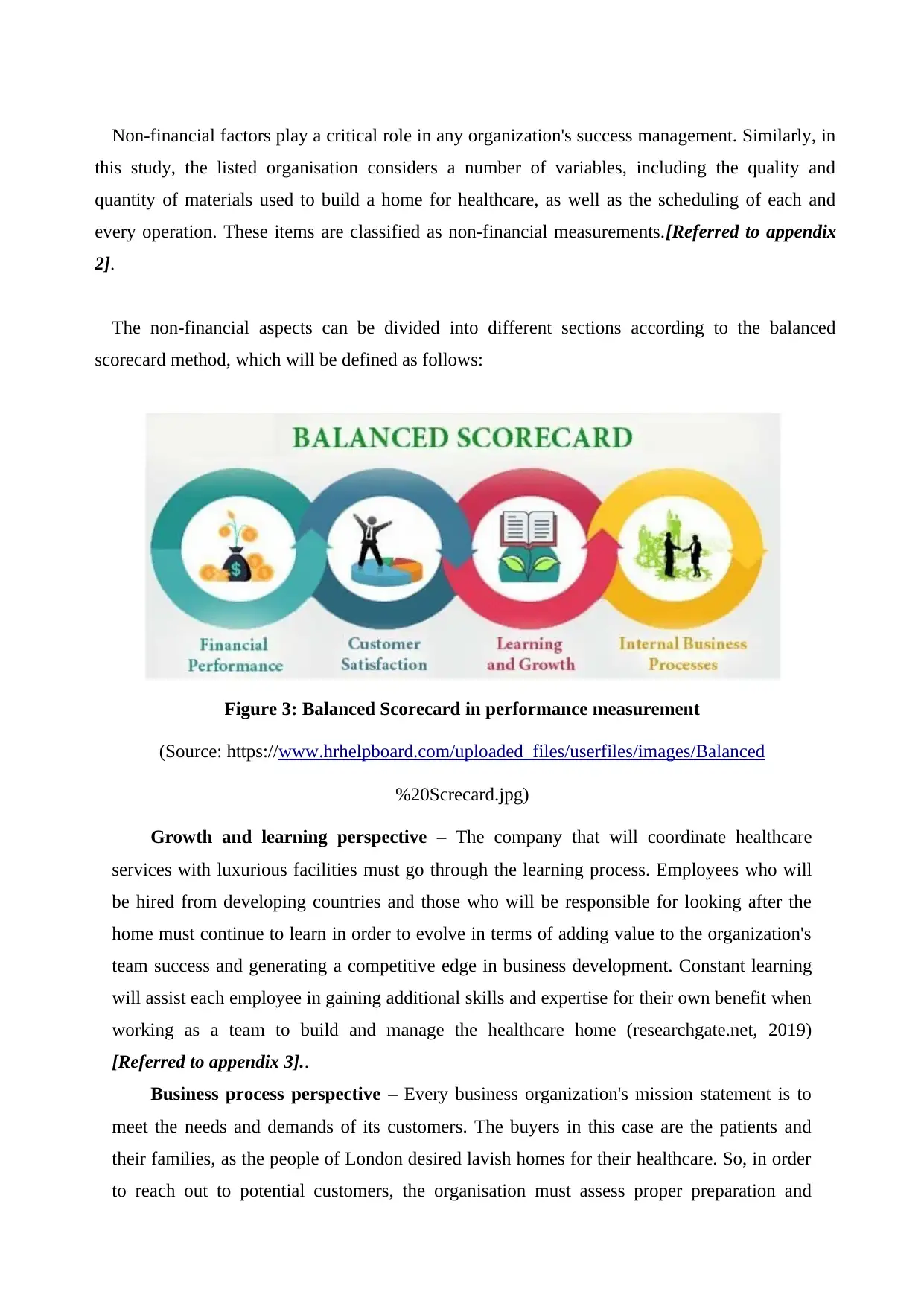
Non-financial factors play a critical role in any organization's success management. Similarly, in
this study, the listed organisation considers a number of variables, including the quality and
quantity of materials used to build a home for healthcare, as well as the scheduling of each and
every operation. These items are classified as non-financial measurements.[Referred to appendix
2].
The non-financial aspects can be divided into different sections according to the balanced
scorecard method, which will be defined as follows:
Figure 3: Balanced Scorecard in performance measurement
(Source: https://www.hrhelpboard.com/uploaded_files/userfiles/images/Balanced
%20Screcard.jpg)
Growth and learning perspective – The company that will coordinate healthcare
services with luxurious facilities must go through the learning process. Employees who will
be hired from developing countries and those who will be responsible for looking after the
home must continue to learn in order to evolve in terms of adding value to the organization's
team success and generating a competitive edge in business development. Constant learning
will assist each employee in gaining additional skills and expertise for their own benefit when
working as a team to build and manage the healthcare home (researchgate.net, 2019)
[Referred to appendix 3]..
Business process perspective – Every business organization's mission statement is to
meet the needs and demands of its customers. The buyers in this case are the patients and
their families, as the people of London desired lavish homes for their healthcare. So, in order
to reach out to potential customers, the organisation must assess proper preparation and
this study, the listed organisation considers a number of variables, including the quality and
quantity of materials used to build a home for healthcare, as well as the scheduling of each and
every operation. These items are classified as non-financial measurements.[Referred to appendix
2].
The non-financial aspects can be divided into different sections according to the balanced
scorecard method, which will be defined as follows:
Figure 3: Balanced Scorecard in performance measurement
(Source: https://www.hrhelpboard.com/uploaded_files/userfiles/images/Balanced
%20Screcard.jpg)
Growth and learning perspective – The company that will coordinate healthcare
services with luxurious facilities must go through the learning process. Employees who will
be hired from developing countries and those who will be responsible for looking after the
home must continue to learn in order to evolve in terms of adding value to the organization's
team success and generating a competitive edge in business development. Constant learning
will assist each employee in gaining additional skills and expertise for their own benefit when
working as a team to build and manage the healthcare home (researchgate.net, 2019)
[Referred to appendix 3]..
Business process perspective – Every business organization's mission statement is to
meet the needs and demands of its customers. The buyers in this case are the patients and
their families, as the people of London desired lavish homes for their healthcare. So, in order
to reach out to potential customers, the organisation must assess proper preparation and
⊘ This is a preview!⊘
Do you want full access?
Subscribe today to unlock all pages.

Trusted by 1+ million students worldwide
1 out of 18
Related Documents
Your All-in-One AI-Powered Toolkit for Academic Success.
+13062052269
info@desklib.com
Available 24*7 on WhatsApp / Email
![[object Object]](/_next/static/media/star-bottom.7253800d.svg)
Unlock your academic potential
Copyright © 2020–2025 A2Z Services. All Rights Reserved. Developed and managed by ZUCOL.





